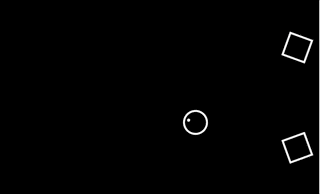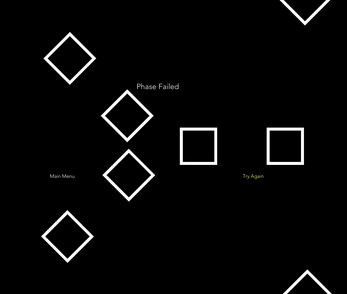High Tension
Press the left and right arrow keys to rotate and hold the spacebar to charge your blast.

HIGH TENSION: A SHORT HISTORY
I came up with this game on accident when I was working on a much more conventional vertical shooting game featuring an omnipresent rubberband force pulling your ship to the bottom center of the screen. At one point I tried moving the ship to the ACTUAL center of the screen just to see what that was like. Doing that made me want to try more realistic Newton's 3rd law physics, letting the player's bullets affect the player's movement, similar to Downwell. So I did that! Using your ship's bullets to move turned out to be more fun than moving with the d-pad/analog. So I went ahead and removed conventional translational controls entirely. The only controls that remained were rotating and charging your ship's blast.
Originally there were many different types of enemies: triangles that shot at you, rotating octagons that laid exploding eggs, and large filled in rectangles that wouldn’t kill you — they’d only carry you to the side of the screen. Then I realized something: the individual enemies, on their own, were all boring and ineffective. The true enemy, the entity the player has to think about and understand in order to kill, is the pattern the enemies come in. By focusing on patterns instead of enemy types, I could constantly give new challenges for the player without confusing them with behaviors they’ve never seen before. So I decided to get rid of all the enemies except for the basic white square — all it does is move slowly towards the center of the screen. Doing this turned the design of this game into a whole new challenge for me: can I make sixteen levels, all of which feel different, using just white squares? This actually was a lot easier than I thought it would be. There’s a huge amount of depth just to different patterns of white squares floating towards the center of the screen.
I don't think I did a good job designing the early levels of this game. It was really hard to use the restrictions I set for myself (one enemy type and one hit kills) to make levels that weren't extremely difficult but were still pretty interesting. There is probably a way to do it! Maybe someday I'll come back to this with better early-game level design.
The later levels were, however, a whole lot of fun to design. I noticed that just rotating and holding a button can feel like different activities depending on how long you’re holding the button, how long you’re rotating, and what’s happening on screen. For example, in one level of this game, the only way to beat it that I’ve discovered is to keep holding the charge button and releasing large shots so that you’re on the left side of the screen as much as possible. You’re negotiating the need to be on the left side of the screen and the need to kill enemies. In other levels you have different constraints to shooting and aiming. You might only need to send small blasts towards every enemy on the screen and stay towards the center as much as possible. In another you might be constantly avoiding enemies. Each of these constraints is a different experience, and a different kind of tension. That meant there was so much I could do with the levels. I am sure I only did a tiny percentage of what these mechanics could have allowed me to do.
One of the things I love about this game is how slow the rotation of your turret is. When you want to shoot something, your brain has two calculations to make instead of just one: “Where will the enemy be when my bullet reaches it?” (The question you ask in a shooting game) and “Where will the enemy be when I finish rotating towards it?” There is often a panicked feeling of “Will I rotate there in time?” that reminds me a lot of the feeling of jumping across a platform in Mario and being terrified I won’t make it. In fact, there are three analogues to that in High Tension: Rotating, Charging, and Moving. With the right design it’s possible for any continuous process to have this feeling. Many platformers miss this. They remove all the continuity that Mario had: for example, when you let go of the arrow keys your player might stop instantly instead of sliding along for a few seconds. Everything fun and scary about Mario is gone instantly. All that’s left is just tapping buttons and seeing what happens. Games like that are often glorified menu systems. Unless they have something else going for them, they’re not fun.
It’s important to me that the player never gets used to doing the same thing over and over. Exposure to too much of that brain atrophy. If you do something new—if you find a new way to play the game and beat a level you’ve been stuck on for hours—you feel good about yourself. It teaches you a little bit more about how the game world works. You slowly come to understand this system of physics and abstract geometry that you’ve been staring at forever. And whenever we understand something outside of ourselves, we learn something new about who we are. I think there’s more to learn about philosophy by spending an hour a day practicing the guitar than there is spending your life reading and rereading Plato. Everything connects to everything. We live in a giant jungle gym of thoughts and feelings. If you stare at one thing long enough, eventually you’ll understand the whole world.
So I hope you can have fun staring at High Tension! Let me know if you make any discoveries.
| Status | Released |
| Platforms | HTML5 |
| Author | saddleblasters |
| Genre | Action, Shooter |
| Made with | Unity |
| Tags | Black and White, Vector |

Leave a comment
Log in with itch.io to leave a comment.